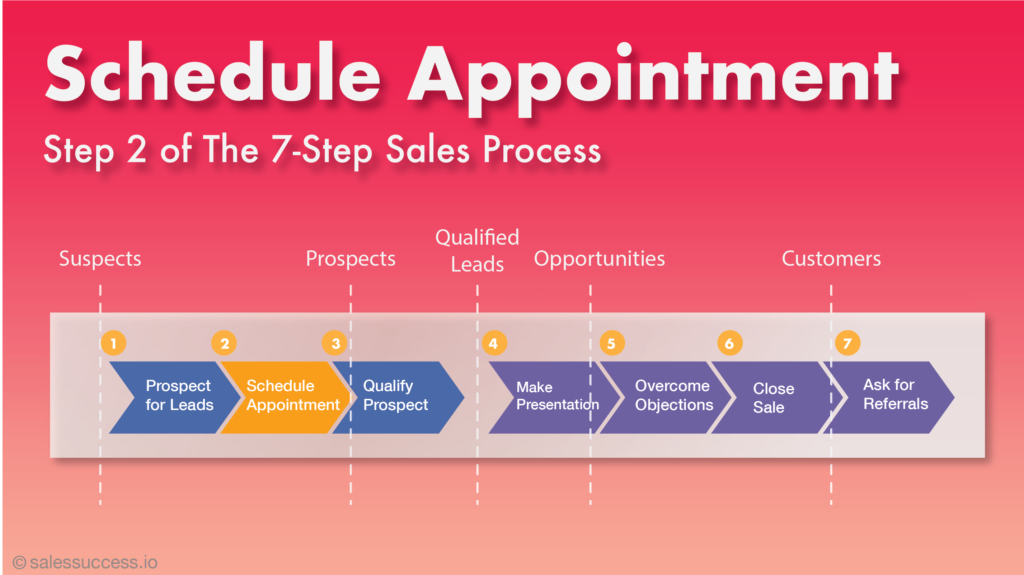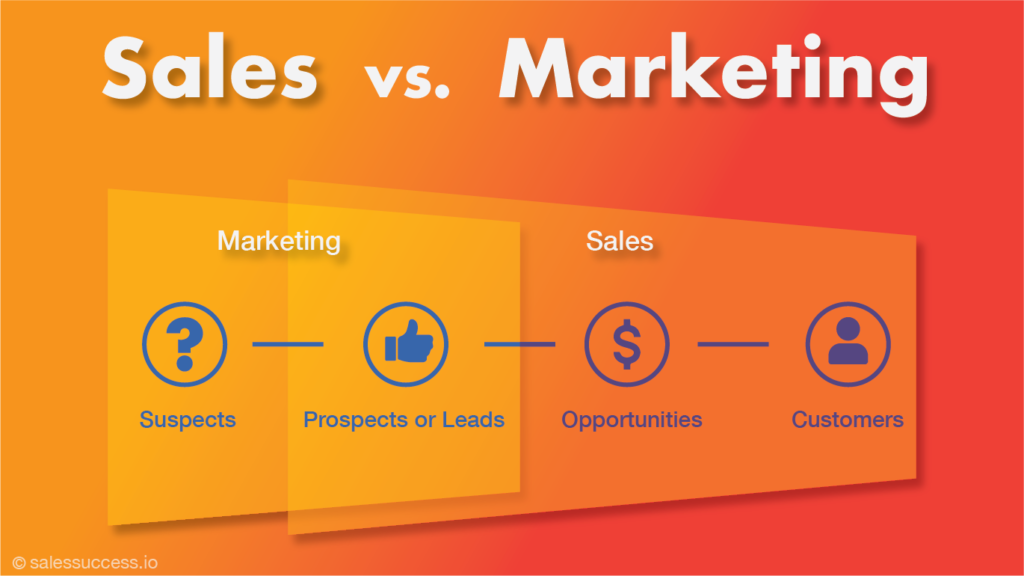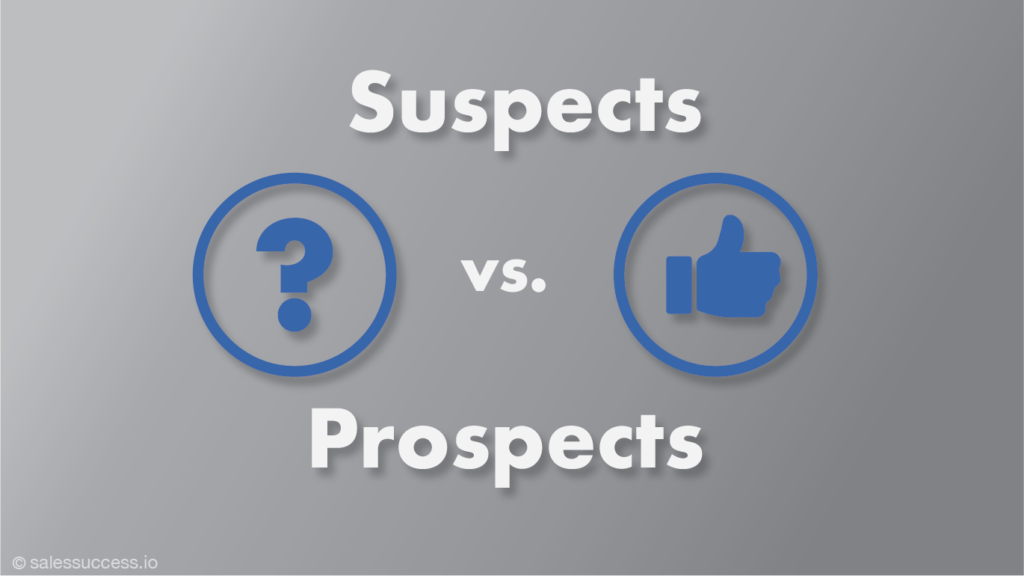- BDR vs. SR: Understanding the Sales Roles and Division of Labor
- Handling Objections: A Guide to Overcoming Customer Concerns
- Making Presentation: Tips for a Compelling and Engaging Delivery
- Qualifying Prospect: The Key to Sales Success
- Setting Appointment: Strategies and Tips for Successful Sales Calls
- Closing Sales: 44 Techniques and the Steps for a Successful Close
- Prospecting for Leads: Finding Your Next Customers
- Sales Process or Cycle: The 7 Steps to Sales Success
![]()
Introduction
We are continuing our blog series on the universal end-to-end sales process. In the first step of the process, you prospect for leads.
In the second step, you schedule or set an appointment with those leads.
But b2b appointment setting services aren’t as easy as just picking up the phone and calling someone out of the blue. It takes more than that. You have to earn the trust of your leads and generate interest in your offering before you can even think about setting appointments.
So how do you do that? In this post, we will share with you the 7 keys to earning trust, generating interest, and setting appointments with prospects. From lead research to follow-up, we will cover everything you need to know to ensure a successful appointment call. Let’s dive in!
5. Multi-channel outreach and sales cadence
7. Follow-up
Lead Research
Lead research is a crucial step before approaching your leads for appointments. You should research your target companies and become familiar with their business and industry.
Review their website and company pages on social media, and go through their newsletters, blogs, annual reports, and investor presentations.
To conduct effective lead research, consider using tools like LinkedIn Sales Navigator or Google Alerts to stay up-to-date on industry news and company updates.
Learn as much as possible about their verticals, competitors, customers, and priorities. Also, learn about individual stakeholders from their social media profiles and company website profiles.
Tailor and contextualize your communications to make them relevant and compelling to the leads.
The upfront research helps you determine and prioritize leads with the best chance of converting into sales. By knowing more about your leads, you can personalize your messaging and show them that you understand their business and their unique needs.
This helps build trust and credibility, making it easier to set appointments and ultimately close deals.
Email Outreach
Cold emailing is an effective way to “warm up” your leads and establish a connection with them. However, instead of sending generic, mass emails, it is important to personalize them for each individual lead.
Keep in mind that spam filters can automatically open emails, so using open rates as a metric for success may not be entirely accurate. Instead, use email tracking tools to monitor engagement levels, such as clicks on links or replies to your emails.
This data can help you prioritize which leads to reach out to first and make your first phone call with more confidence. If a lead responds positively to your emails, use that opportunity to build rapport and move towards scheduling an appointment.

Read the book here.
Pre-Call Preparation
To maximize your chances of success in cold calling, you need to plan and prepare carefully beforehand. Start by defining your value proposition and what you can offer to the prospect. Avoid using a generic cold calling script and instead adapt it to the particular lead based on your research.
Be prepared to leave a voicemail if the prospect does not answer. In this case, aim to grab their attention within the first few seconds of your message. Remember that making a great first impression is critical to your appointment-setting success.
Call Etiquette
When it comes to calling leads for the first time, it is crucial to approach the conversation with a certain level of etiquette. Do not be pushy or forceful about having the conversation if the lead isn’t ready – schedule a better time for both of you to talk.
Pay attention to the tone of your voice – speaking slowly, clearly, and confidently can help build trust with your lead. Remember, your energy should radiate through the phone and create a positive impression.
If you are speaking with warm leads that have already engaged with your email outreach or been passed on by marketing, it is important to build rapport initially through small talk. This can help set the tone for the conversation and put your lead at ease.
The small talk can create a positive atmosphere and help to establish a connection with the prospect before jumping into the business conversation. However, it is important to be mindful of the prospect’s time and not let the small talk extend for too long.
It is also important to be genuine and authentic in your conversation, as prospects can easily detect when someone is just going through the motions.
Multi-Channel Outreach and Sales Cadence
Multi-channel outreach is key to reaching leads and increasing the chances of setting appointments. Besides emails and calls, you can also use SMS or text messages, WhatsApp, and social media channels such as LinkedIn.
To maximize the impact of your outreach, create a sales cadence that outlines a structured approach to follow-up with leads over a set time period. This approach helps you process a high volume of leads quickly and efficiently.
For example, you can create a 5-day approach plan that includes a 1-day pause in between. On day 1, send an introductory email and connect with the lead on LinkedIn. On day 2, make a phone call and leave a voicemail if the lead is not reachable. On day 3, make a second phone call attempt but don’t leave a voicemail. Day 4 is a pause. On day 5, send the intro email again and make a third and final phone call attempt.
At the end of the 5-day period, if you have not received a response or connection from the lead, it may be time to move on to the next lead in your pipeline. Remember to continually evaluate and adjust your sales cadence to optimize your outreach efforts.
Top of the Funnel (TOFU)
TOFU marketing
To generate interest in leads, it is important to provide valuable information about your product or service. One effective way to do this is through content marketing.
Create informative and engaging content that addresses the challenges your prospects are facing and positions your product or service as a solution.
Utilize different content formats such as blog posts, whitepapers, webinars, podcasts, and case studies to engage with your leads on multiple channels.
You can also use LinkedIn to connect with your leads and share relevant content. LinkedIn is a great platform to establish your authority and engage with potential customers in a more informal setting.
Remember, the top of the funnel is about educating your leads and building relationships, not just pushing your product or service on them. Take the time to understand their needs and provide valuable solutions before attempting to schedule an appointment.
Follow-up
Following up after setting the appointment is crucial to ensure the lead doesn’t forget or overlook it. Send a confirmation email with the meeting details and agenda.
After the appointment, follow up again to thank them for their time and confirm the next steps. This will help build a relationship with the lead and keep them engaged in the sales process.
No Shows
Even with careful planning and follow-up, no-shows may still happen. In such cases, do not give up on the lead. Instead, follow up with them and reschedule the appointment.
If the no-shows continue, re-evaluate your approach and see if there are any areas for improvement. Perhaps the timing of the appointment needs to be changed or the messaging needs to be revised. Use these insights to refine your sales cadence and approach.
Conclusion
Setting appointments can be a challenging but rewarding part of the sales process. By following these tips and strategies, you can improve your chances of securing a successful sales call and ultimately closing more deals.
Remember to stay persistent, personalize your approach, and always follow up with prospects. With the right mindset and approach, you can turn setting appointments into a key driver of your sales success.
Subscribe to our Blog



